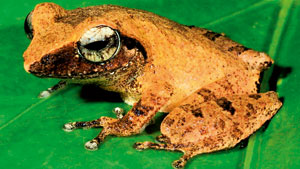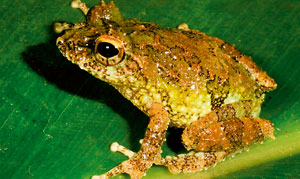The researchers were looking for frogs on a cold night at the edge of the Sinharaja rainforest. Suddenly, one picked up a rapid ticking noise he had never heard before coming from a tea bush. Listening carefully, he started combing the bushes searching for the source of the noise. Looking at the researcher through two really large eyes was a tiny frog with a long snout.
That was in 1999.
“Since a call, within reason, can also be used in species identifications, I knew that we potentially had a new species,” said Madhava Meegaskumbura, who had since then worked together with Kelum Manamendra-Arachchi to introduce this frog as a new species. Their efforts bore fruit last week with this information being published as a paper in a science journal, officially updating Sri Lanka’s Amphibian list.
 |
| Pseudophilautus hankeni |
 |
| Pseudophilautus schneideri |
The tiny frog found in the tea estate is only about 2.28 cm and was named Pseudophilautus schneideri. Later studies by the team of researchers recorded them in other lowland areas like tea plantations in the Sinharaja buffer zones, Kanneliya and Elpitiya. “They prefer open areas near humid forests,” says Madhava.
Madhava’s research also introduced a second shrub frog that is even smaller. This one lives in the cloud forests at a high elevation in Sri Lanka’s hill country. The team working on another hill country frog that inhabited Horton Plains in the late 1990s had encountered a frog similar to the Horton Plains one in the high peaks of Knuckles.
The mountain species named Pseudophilautus hankeni is only about 2.19 cm and was found in the cloud forests in the Knuckles range in Riverston and Bambaraella.
Many new species are named after the researcher, who discovers them, but these frogs are differently named - Madhava was quick to explain. Both these species are shrub frogs; hence they belong to a frog genus called Pseudophilautus and have that name as the first part of their name. (Scientists categorize a group of species with similar characteristics that are closely related into a genus.)
The second part of the name too was different. “Basically, any name can be given, but usually latinized. I named these frogs to honour my teachers at PhD level, at Boston University: Prof. Christopher Schneider and at post doctorate level at Harvard University Prof. James Hanken,” said Madhava. The last two frogs Madhava found were named Pseudophilautus singu and Pseudophilautus tanu -both names in early Sinhalese for "horned" and "petite" respectively.
Tedious scientific process
So far Madhava has discovered 14 frog species and five fish species. The researcher based at Peradeniya University together with his wife Suyama Meegaskumbura, also discovered a shrew from Sinharaja. The scientific process to describe these new species is a tedious one, he relates. Once a researcher finds a different species he suspects is a new one, he has to measure and analyze each and every tiny detail against the specimens of already found species. Explaining the process, Madhava said the analysis is usually three-pronged – Morphological Analysis, Morphometric Analysis and Molecular Analysis.
During the Morphological analysis, a researcher describes various characteristics of the animal - how the snout looks (pointed, circular etc.), if it has tubercles on its belly, the shape of the iris, if there are special folds around its eyes, etc. During the Morphometric analysis researchers try to see if the body form of one species is different from another.
The most conclusive to distinguish an animal as a separate species is the DNA test known as the Molecular Phylogenetic Analysis. Scientists take a bit of DNA from the species under consideration, and compare it with other known forms. You need to amplify a specific region of gene for this, and determine the genetic code. Once this is done, you can compare, and use statistical methods to determine relationships among various species.
“Now we are having more and more access to molecular facilities, and at Peradeniya, we have facilities to do this sort of work. For my PhD, however I did most of the work in a US university, as such facilities were not available in Sri Lanka at that time,” said Madhava.
Direct developers
With the new discovery, the number of Sri Lankan frogs from this genus goes up to 67. The common belief is that frogs always live near waterways, but water is not necessary for the survival of these shrub frogs though humidity is essential. The highest diversity and density of these frogs are found in the most humid areas of Sri Lanka in and around low country rainforests and cloud forests in the central highlands.
What we are taught is that frogs have an interesting reproductive cycle with a stage as tadpoles. But these two species do not have a tadpole stage, and hence are known as Direct Developers. They dig a little hole in the soil and deposit their eggs. All the developmental stages are spent within the egg and fully formed baby frogs emerge directly from the eggs, said Madhava. “There are plenty of such direct developers among our frogs. Already 48 such direct developers are named among existing frogs in Sri Lanka, so out of the living amphibians of Sri Lanka, a little less than half are direct developers that don’t have tadpoles.”
Madhava is thankful to Kelum Manamendra-Arachchi (of the Postgraduate Institute of Archaeology), his long time colleague and friend, for co-authoring the paper describing these two new species. |



